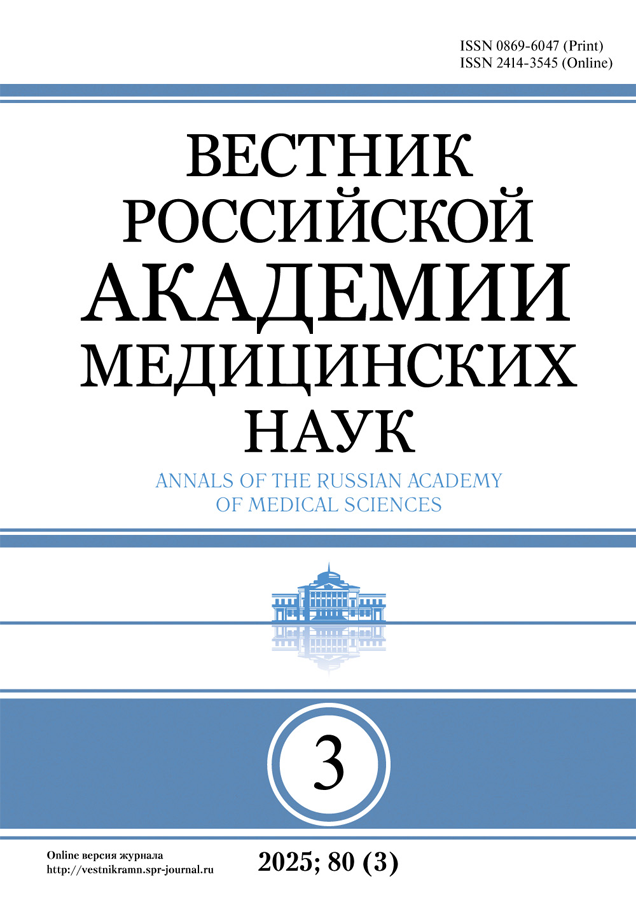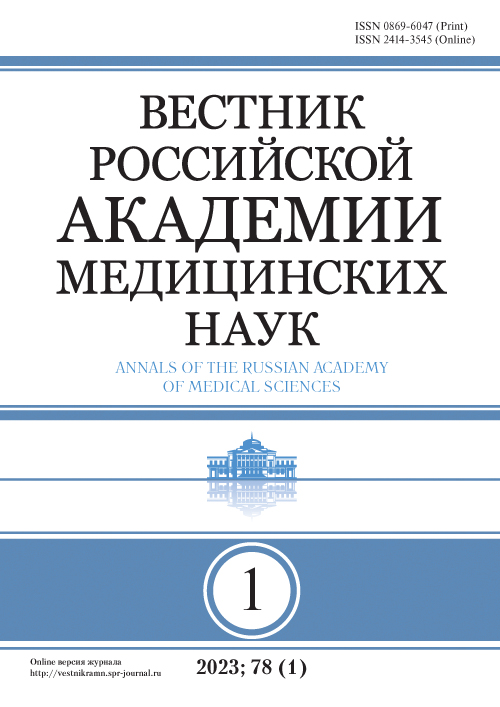Том 78, № 1 (2023)
- Год: 2023
- Дата публикации: 04.03.2023
- Статей: 8
- URL: https://vestnikramn.spr-journal.ru/jour/issue/view/90
- DOI: https://doi.org/10.15690/vramn.781
Весь выпуск
АКТУАЛЬНЫЕ ВОПРОСЫ АКУШЕРСТВА И ГИНЕКОЛОГИИ
Характеристика иммунного ландшафта при эндометриозе
Аннотация
Обзор посвящен эндометриоз-ассоциированным иммунным клеткам и иммунным молекулам, анализу различных баз данных, а также полученным новым представлениям, теориям, биомаркерам, исследованиям в этой области. До настоящего времени было предпринято много попыток определения роли иммунных клеток и микроокружения в развитии эндометриоза. Тем не менее, несмотря на интенсивные исследования эндометриоза, роль клеток и молекул воспаления освещена не в полном объеме. Сегодня достаточно поверхностно изучены патобиология эндометриоза и роль в прогрессировании заболевания местной и системной воспалительной реакции. Не уточнены роль иммунной системы и ее значение в патогенезе эндометриоза, в том числе в случаях атипичного эндометриоза и эндометриоз-ассоциированных опухолей яичников. Вышеизложенное требует дальнейшего изучения данной проблемы с целью оптимизации патогенетически обоснованной современной терапии эндометриоза.
 5-10
5-10


АКТУАЛЬНЫЕ ВОПРОСЫ ВНУТРЕННИХ БОЛЕЗНЕЙ
МРТ для количественного определения железа в печени и сердце у пациентов с первичными и вторичными гемохроматозами во взаимосвязи с ферритином сыворотки крови: одномоментное обсервационное исследование
Аннотация
Обоснование. Выполнено крайне небольшое количество исследований, посвященных изучению различий показателей концентрации железа в печени (liver iron concentration, LIC) и концентрации железа в миокарде (myocardium iron concentration, MIC), а также их корреляции между собой и с уровнем ферритина у пациентов с различными нозологическими формами. Цель исследования — изучение взаимосвязи уровня ферритина, LIC и MIC у пациентов с различными причинами гемохроматоза (наследственный гемохроматоз, апластическая анемия (АА), первичный миелофиброз (ПМФ), талассемия (ТЛ), миелодиспластический синдром (МДС)). Методы. Проведено одномоментное обсервационное исследование, в которое был включен 91 пациент с первичными гемохроматозами и вторичными трансфузионно-зависимыми гемохроматозами, получающие регулярное переливание крови и терапию хелаторами железа с 2015 по 2018 г. Исследование проводили на высокопольном томографе Siemens Magnetom Espree (Германия) с индукцией магнитного поля 1,5 Тл. Концентрацию железа в миокарде (MIC) рассчитывали по формуле MIC = 45 × (T2*) – 1,22, концентрацию железа в печени — по формуле LIC = 0,03 × R2* + 0,74. Уровень ферритина определялся с помощью иммуноферментного анализа. Статистическая обработка полученных результатов проводилась с использованием программного пакета SPSS. Результаты. Выявлены связи между LIC и ферритином (r = 0,867; p < 0,001), MIC и ферритином (r = 0,759; p = 0,004) и LIC и MIC (r = 0,737; p = 0,006) у пациентов с первичным гемохроматозом, в то время как у пациентов со вторичным гемохроматозом значимые корреляции выявлены только между LIC и MIC (r = 0,503; p < 0,001), при этом связь была средней. Выявлены средние связи между LIC и ферритином у пациентов с АА (r = 0,656; p = 0,040) и у пациентов с ТЛ (r = 0,714; p = 0,020). Выявлены средние связи между MIC и ферритином у пациентов с АА (r = 0,703; p = 0,050) и у пациентов с ТЛ (r = 0,757; p = 0,018). При этом у пациентов с МДС и ПМФ в данном исследовании не было выявлено связи между ферритином и LIC, ферритином и MIC. Заключение. У пациентов с наследственным гемохроматозом LIC и MIC связаны с ферритином, а также MIC связан с LIC (средняя связь). У пациентов с перегрузкой железом вследствие талассемии выявлена средняя связь между LIC и ферритином, MIC и ферритином. У пациентов с перегрузкой железом вследствие АА выявлена средняя связь между LIC и ферритином, MIC и ферритином.
 11-18
11-18


АКТУАЛЬНЫЕ ВОПРОСЫ ИНФЕКЦИОННЫХ БОЛЕЗНЕЙ
Роль инфекций в патологии человека
Аннотация
Инфекционные болезни вследствие эпидемического потенциала способны к глобальному распространению и отличаются непредсказуемостью, их эффективный контроль возможен лишь в планетарном масштабе. Ни в одной другой области медицины за короткий срок не происходят таких коренных и часто непредсказуемых изменений в виде ликвидации отдельных болезней, выявления большого числа неизвестных ранее и возвращения уже забытых заболеваний, существенного изменения патогенеза и клинической симптоматики значительного их числа. В этих условиях указанные изменения нередко создают проблемы для органов здравоохранения и общественности, опережают их способности осознавать и своевременно реагировать на возникновение эпидемий и трансформацию патологических проявлений. Значительный научный прогресс последнего времени лишь в малой степени прояснил наши знания о биологическом и генетическом разнообразии возбудителей болезней. До настоящего времени остается неясным весь спектр инфекционной патологии, и его многочисленные проявления нередко застают врасплох даже опытных специалистов. Свидетельствами ограниченности наших знаний и возможностей контролировать ситуацию являются текущая уже третий год пандемия COVID-19, все более частое выявление «новых» инфекций, возврат инфекций, объявленных побежденными, доказательства роли инфекционных факторов в этиологии многих других болезней человека.
 19-23
19-23


АКТУАЛЬНЫЕ ВОПРОСЫ ОНКОЛОГИИ
Антивозрастной белок Клото как новый потенциальный супрессор опухолевого роста
Аннотация
С момента своего открытия 20 лет назад белок Клото активно изучается во всем мире. Выявлено, что его изомер α-Клото тесно связан с процессами старения и обладает антивозрастными свойствами. В экспериментальных работах было показано, что α-Клото универсально воздействует на многие биологические механизмы, ведущие к гиперпластическим изменениям клеток и тканей, ингибирует известные канцерогенные пути с вовлечением инсулиноподобного фактора роста 1 (IGF1), фактора роста фибробластов (FGFs), трансформирующего фактора роста β1 (TGFb1), Wnt, P53/p21, а также воздействует на путь окислительного стресса (oxidative stress response). Все больше научных данных указывает на то, что белок Клото влияет на развитие таких видов злокачественных опухолей, как рак молочной и поджелудочной желез, легких, желудка, гепатокарциномы и др. В данном обзоре рассматривается роль α-Клото в онкогенезе, его влияние на основные сигнальные пути развития злокачественных опухолей и возможности регуляции его экспрессии.
 24-44
24-44


АКТУАЛЬНЫЕ ВОПРОСЫ ОРГАНИЗАЦИИ ЗДРАВООХРАНЕНИЯ
Фронтиры и структурные трансформации глобального фармацевтического рынка
Аннотация
Обоснование. Для достижения технологического суверенитета Российской Федерации, превращения имеющихся научных заделов в востребованные технологии и технологически независимые секторы экономики особое внимание уделяется фронтирным направлениям мировой науки. Под фронтирами понимаются тематические области, на базе которых в парадигме импортоопережения будут разрабатываться российские критические технологии. Цель исследования — выделение наиболее перспективных ниш глобального фармацевтического рынка и фронтирных исследовательских направлений, ориентированных на их экспансию. Методы. Анализ объемов финансирования НИОКР ведущими фармацевтическими компаниями мира в период 2015–2022 гг., многокритериальный наукометрический анализ и тематическое картирование коллекции наиболее высокоцитируемых обзоров, опубликованных в 2020–2022 гг. и проиндексированных в БД Scopus. Результаты. Выполнен анализ объемов финансирования НИОКР ведущими фармацевтическими компаниями мира в 2015–2022 гг. и среднегодовых темпов их роста. Показано, что при ежегодном увеличении корпоративного бюджета на НИОКР в 2,8% к 2022 г. совокупные расходы на НИОКР ключевых игроков глобального фармацевтического рынка достигли 182 млрд долл. в год. При этом 60% этих средств (109,4 млрд долл.) пришлось в 2022 г. на топ-20 мировых фармацевтических компаний, инвестирующих в разработку новых лекарственных препаратов. Для сравнения приведены внутренние затраты на исследования и разработки Российской Федерации, которые с учетом дефлятора ВВП по состоянию на 8 апреля 2022 г. оцениваются в 48 млрд долл., из которых объемы бюджетного финансирования, предусмотренные в 2023 г. по приоритетному направлению Стратегии научно-технологического развития Российской Федерации «Переход к персонализированной медицине, высокотехнологичному здравоохранению и технологиям сбережения здоровья, в том числе за счет рационального применения лекарственных препаратов (прежде всего антибактериальных)», составят 39,5 млрд руб. Для актуализации перечня приоритетных направлений исследований и разработок выделены наиболее перспективные ниши глобального фармацевтического рынка и исследовательские направления, ориентированные на их экспансию. Заключение. В результате выполнения многокритериального наукометрического анализа и тематического картирования коллекции наиболее высокоцитируемых обзоров, опубликованных в 2020–2022 гг. и проиндексированных в БД Scopus, выделено 10 фронтирных направлений исследований, имеющих потенциал трансформации структуры глобального фармрынка.
 45-52
45-52


АКТУАЛЬНЫЕ ВОПРОСЫ ФАРМАКОЛОГИИ И ФАРМАЦИИ
От молекулы до лекарства. Фармакологистический подход
Аннотация
Разработка оригинальных лекарственных средств — сложный, длительный, трудоемкий, затратный и рискованный процесс. Фармацевтическая отрасль является критически важной областью технологического суверенитета страны. Эффективное функционирование системы лекарственного обеспечения невозможно без создания оригинальных лекарственных препаратов, обеспечивающих фундамент для поступательного развития целого ряда отраслей социально-экономического сектора экономики страны. Отечественная фармакология сталкивается с рядом нерешенных задач, многие из которых должны рассматриваться через призму фармакологических дисциплин, в первую очередь теоретической и клинической фармакологии, а также учитывая эволюцию применяемых в них подходов. Фармакологистика представляет собой систему мышления фармакологов и специалистов в области разработки лекарств, преследуя цель не только повысить качество и количество создаваемых лекарственных средств, но и ускорить этот процесс. В данной статье приведено описание сути фармакологистического подхода, кратко рассмотрены основные этапы разработки оригинального лекарственного средства — от идеи до исследований, проводимых после широкого внедрения препарата в клиническую практику. В завершении статьи авторами представлен успешный опыт применения фармакологистического подхода фармакологами ФГБОУ ВО ВолгГМУ на примере разработки нового оригинального лекарственного средства для лечения сахарного диабета и его осложнений.
 53-61
53-61


АКТУАЛЬНЫЕ ВОПРОСЫ ХИРУРГИИ
Ретроспективное когортное исследование эффективности плазменной хирургии доброкачественной гиперплазии простаты больших и гигантских размеров
Аннотация
Обоснование. За последние 10 лет в 3–4 раза возросла частота случаев доброкачественной гиперплазии простаты (ДГП) свыше 80 см3. При показаниях к хирургическому лечению сегодня все чаще используют трансуретральные методы с применением лазерной или плазменной техники резекции и энуклеации простаты. В статье представлен сравнительный анализ результатов плазменной трансуретральной энуклеации простаты и открытой простатэктомии, методов хирургической и медикаментозной профилактики дизурических осложнений, что свидетельствует о первостепенности выбора плазменной трансуретральной энуклеации простаты в хирургии ДГП больших и гигантских размеров. Цель исследования — доказать эффективность применения плазменных хирургических методов и схемы комплексной медикаментозной послеоперационной профилактики поздних дизурических и рубцовых осложнений при лечении доброкачественной гиперплазии простаты больших и гигантских размеров. Методы. Дизайн ретроспективного когортного исследования включал несколько этапов, проведенных на базе урологического центра клинической больницы «РЖД-Медицина», г. Нижний Новгород, в 2008–2019 гг. Объектом изучения были пациенты с подтвержденным диагнозом ДГП большого (свыше 80 см3) и гигантского (свыше 250 см3) размеров, разделенные на основную и контрольные группы по методам хирургического вмешательства и послеоперационной профилактики дизурических осложнений. Отбор пациентов проведен методом парного дизайна с равным количеством наблюдений и максимальной сопоставимостью исходных параметров. Анализ данных проведен методами параметрической и непараметрической статистики, многомерного статистического анализа. Результаты. Сравнение результатов плазменной трансуретральной энуклеации простаты (n = 122) и открытой простатэктомии (n = 122) в группах пациентов с большим и гигантским объемом ДГП показало возможность снижения интраоперационной кровопотери в 1,5 раза, длительности катетеризации мочевого пузыря — в 3,8 раза, частоты ранних послеоперационных осложнений — в 1,7 раза и сроков госпитализации — в 2,9 раза, что значимо экономит больничные расходы. Модификация начального этапа плазменной трансуретральной энуклеации простаты, заключающаяся в создании доступа к железе с применением новых анатомических ориентиров для максимального сохранения переднего фибростромального комплекса, сокращает риск травмы наружного сфинктера уретры, что доказано трехкратным снижением частоты стрессовой инконтиненции после операции. В целях профилактики поздних дизурических и рубцовых осложнений плазменной трансуретральной энуклеации простаты разработана схема комплексной медикаментозной послеоперационной профилактики с применением препарата гиалуроновой кислоты (ГК). Гистологически и клинически подтверждено, что инстилляции раствора ГК в мочевой пузырь в комплексе со стандартной послеоперационной терапией позволяют в 2–4 раза ускорить репаративные процессы и избавиться от ирритативной симптоматики на 6–12-й послеоперационной неделе в зависимости от объема удаленной ДГП. Заключение. Доказаны обоснованность применения, клинико-экономическая эффективность, высокий профиль безопасности и первостепенность выбора плазменной трансуретральной энуклеации простаты в хирургии ДГП больших и гигантских размеров, в том числе ее модифицированной техники и комплексной схемы медикаментозной профилактики поздних осложнений.
 62-76
62-76


ЮБИЛЕИ
К 70-летию академика РАН Евгения Лхамацыреновича Чойнзонова
Аннотация
14 декабря 2022 г. исполнилось 70 лет Евгению Лхамацыреновичу Чойнзонову — доктору медицинских наук, профессору, академику РАН, заслуженному деятелю науки РФ, директору НИИ онкологии Томского национального исследовательского медицинского центра РАН, заведующему кафедрой онкологии Сибирского государственного медицинского университета (г. Томск).
 77-78
77-78













